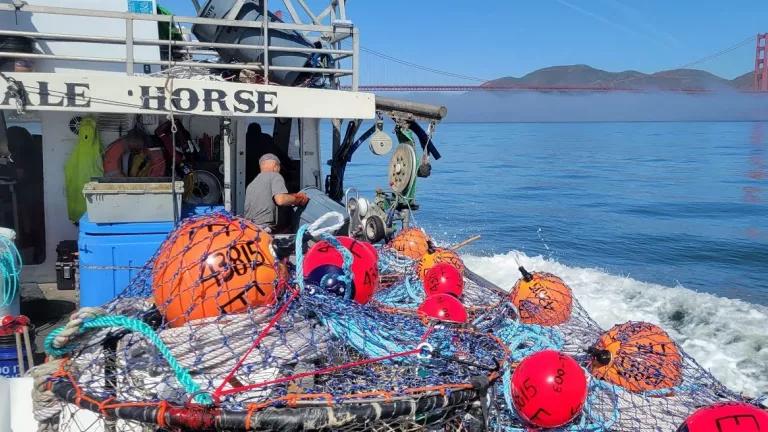California’s Entanglement Regulations: The Stronger the Better
To protect endangered whales and sea turtles from entanglements in California, several regulatory improvements are necessary.

Humpback whales are one of several large whale species vulnerable to entanglement in fishing gear off California's coast. Pacific leatherback sea turtles are also at risk.
Monterey Bay National Marine Sanctuary
California’s ocean is renowned for its stunningly diverse marine life. Majestic whales and sea turtles are regular visitors, stopping just off the state’s coast to feed and socialize during their migrations. Several of these visitors—blue whales, some humpback whale populations, and Pacific leatherback sea turtles, for example—are listed as endangered or threatened under the Endangered Species Act, making it all the more important that we protect them during their long journeys. California is also known for its vibrant fisheries, which unfortunately means that whales and sea turtles can sometimes become entangled in fishing gear.
The California Department of Fish and Wildlife (the Department) is proposing new regulations to reduce the risk of endangered whales and sea turtles becoming accidentally entangled in fishing gear associated with the California commercial Dungeness crab fishery. The new regulations update the state’s Risk Assessment Mitigation Program (or “RAMP”), which was first adopted in the fall of 2020 and represented a progressive and dynamic management approach to reducing entanglement risk. The Department is receiving public comment on the proposed 2024 RAMP regulations through Tuesday, May 21st.
Over the last decade, climate change has increased the extent to which whales and fishing activities overlap as changes in ocean temperature have begun to influence migratory patterns. As a result, numbers of entanglements have increased beyond levels considered sustainable for already endangered populations. Entanglements in the vertical buoy-lines used to mark crab pots and lobster traps are particularly serious, often killing animals or leading to agonizing injuries. Over the longer term, entanglements can cause chronic health issues, starvation, and reproductive impairment. Entanglements are also bad news for fisheries, leading to fishery closures and economic uncertainty in some cases.

An entangled humpback whale with multiple wraps of line around the head and a buoy belonging to the California commercial Dungeness crab fishery, documented off Monterey, California. Whale lice, seen on the back of the whale, are an indication of poor health.
Marine Life Studies; MMRSRP Permit #24359
Despite California’s adoption of the RAMP regulations in 2020, entanglements have continued to occur at a high rate. For example, in 2023, seven of the 27 entangled large whales confirmed off the U.S. West Coast originated from the California commercial Dungeness crab fishery. A dead leatherback sea turtle was similarly found entangled in California commercial Dungeness crab fishing gear off the Farallon Islands. Only a small fraction of whale and sea turtle entanglements are ever detected, so the actual number of entanglements occurring is likely to be significantly higher.
The Department should use this opportunity to significantly strengthen its new RAMP regulations, beyond what is currently proposed. Strong, updated regulations are needed to reduce entanglement risk more effectively, and will also help move the state towards achieving the California Ocean Protection Council’s stated goal of zero mortality of whales and sea turtles statewide.
NRDC recommends that the Department incorporate the following measures in the final 2024 RAMP regulations:
- Require more conservative limits on entanglements of humpback whales, blue whales, and Pacific leatherback sea turtles. Adherence to entanglement limits should be assessed on a precautionary 3-year rolling basis and account for out-of-season entanglements.
- Allow all fishing zones to be closed in response to entanglements of Pacific leatherback sea turtles, or if high concentrations of turtles are observed in those zones.
- Both surface gear and the full line must be uniquely marked in a manner that allows the gear to be traced back to the California commercial Dungeness crab fishery. Painted line may be used in the interim, but the fishery must have transitioned to a unique manufactured line by 2028.
- Additional measures and accountability with independent verification are required to reduce lost gear. Examples include a new requirement to return all trap tags to CDFW at the end of each fishing season, and trap reductions for permit holders who lose large amounts of gear.
NRDC also urges the Department to authorize pop-up gear as alternative gear for commercial fishing before the start of the next fishing season. Authorization will allow fishers who choose to use this new technology to keep fishing in the spring, when the fishery is closed to conventional fishing gear due to heightened entanglement risk to endangered species. Pop-up gear virtually eliminates entanglement risk by removing vertical lines and surface gear from the water column while allowing fishers to remain in business. This innovative technology has proven successful in Experimental Fishing Permits, and significant new state funding has recently been awarded to further support its testing and use.
While the Department has done substantial work to protect California’s treasured marine life, these additional steps are crucial. By implementing the above recommendations, the Department will continue its leadership in the proactive management of entanglement risk and allow continued fishing opportunities while protecting whales and sea turtles.




